#I love the 1925 film so so much
Explore tagged Tumblr posts
Text
Newest video editing project. 1925 Valjean paired with the song Time Will Change You by The Crane Wives. Hope y’all like this one.
#this medium is still a little tricky for me but I’m having fun#I love the 1925 film so so much#les mis#les miserables 1925#jean valjean#video edit
22 notes
·
View notes
Text










Ronald Colman, George K. Arthur, and Constance Talmadge in HER SISTER FROM PARIS (1925) dir. Sidney Franklin
#i love this silly trio so much#still making gifs using the wackiest method ever but whateverrrrrr#ronald colman#george k arthur#constance talmadge#her sister from paris#her sister from paris 1925#films#silent film#my edit#my post#cinemaspast#classicfilmsource#my gifs
15 notes
·
View notes
Text






Sunderland's Royal Jewel Vault (54/∞) ♛
↬ Queen Alexandra's Sapphire Tiara
Early into her marriage, Queen Alexandra feuded with her in-laws, particularly her mother-in-law, the Dowager Duchess of Glencairn. As the daughter of Emperor Alexander II of Russia, Alexandra was bequeathed a magnificent jewellery collection which she boasted frequently. By 1862, the Sunderlandian royal duchesses and princesses were sorely jealous of Alexandra’s diamonds, the Dowager Duchess most of all. The duchess blamed Alexandra for living a life of imperial luxury in the secular, fledgeling state of Sunderland. Alexandra defended herself, stating that, as queen, she was entitled to a splendid wardrobe “as would be expected in all civilized nations.” As her relationship with the duchess continued to break down, Alexandra wrote angry letters to her parents. The young queen described her mother-in-law as an “arrogant, miserable old shrew.” The rivalry enraged Empress Maria, who wrote to George I, urging him to defend her daughter from “a mother-in-law so foul-mannered and unserious.” King Nicholas later reflected, “My mother and grandmother respected each other, but they were both strong in character and could never see eye to eye.” It was around this time that yet another tiara entered Alexandra’s jewellery box. A sapphire button tiara with diamond scroll elements. Alexandra wrote about the tiara and its matching parure in January 1869: “Much pleased with the lovely tiara & necklace my dear George arranged for me. The sapphires were mine & the diamonds from George’s Aunt Wilhemina & Aunt Westminster. It’s all so beautiful & in good taste . . .” Alexandra was first depicted wearing the tiara in an 1865 portrait. She later wore the tiara to the wedding ceremony of her third son, Prince William, in 1891. After Alexandra died in 1925, it was left to her daughter-in-law, Princess Thyra of Denmark, the Duchess of Albion. Thyra, who had a knack for social work and enjoyed “being among the people”, was painted in the tiara and wore it to the enthronements of her brother-in-law, King Nicholas, in 1921 and her nephew, George II, in 1930. Following, Thyra’s death in the mid-1940s, the tiara was passed to her own daughter-in-law, Madeline, Countess of Lennox. Several photographs of the countess wearing the piece were snapped in the 1950s. At some point in the 1950s, the tiara was loaned to the countess’s second daughter, Ruth. As a male-line great-granddaughter of George I, Ruth was styled Her Highness Princess Ruth of Albion until 1943, when King George II restricted princely titles. After this, Ruth became known as Lady Ruth Warwick. Following the loss of her title, Ruth became “aimless” and pursued a short-lived film career, starring in sex comedies “nobody had ever heard of”. According to Princess Alice, George II’s younger daughter, Ruth had failed aspirations to pose for Playboy. “She had the body but not the face,” Alice wrote laconically in her journal. The press ironically dubbed Lady Ruth the “royal family’s smartest dumb blonde.” Ruth wore the tiara to the enthronement of James II in 1956. She never got a chance to wear it to the 1970 enthronement of Louis V, her second cousin once removed. In 1969, Ruth died after crashing her car into a telephone pole. She was thirty-three years old. The funeral was attended by Queen Katherine, Prince Louis and his new wife, Irene, and Prince Clarence. The ailing James II, too weak to attend, noted that he’d had a “crush” on “Cousin Ruth”, who was twenty years his junior. However, the king was also dismissive, stating that Ruth probably crashed because “she was driving like James Dean or something.” Ruth’s death marked the end of the clear line of inheritance of the sapphire tiara. Today, the tiara’s whereabouts are unknown. Most likely it was inherited by one of Ruth’s sisters and subsequently sold or broken up.
#warwick.jewels#✨#ts4#ts4 royal#ts4 edit#ts4 royal legacy#ts4 legacy#ts4 royalty#ts4 monarchy#ts4 screenshots#sims 4#simblr#the sims 4#sims#the sims community#sims 4 screenshots#my sims#ts4 simblr#warwick.extras
47 notes
·
View notes
Text
LOTR/Hobbit Characters and Their Favorite Horror Movies — Part II (still with little to no context)
Phantom of the Opera (1925) for Bilbo — Lon Chaney and silent film lover. It’s a pretentious pick but he’d have it no other way. Enjoys the other iterations of the film—even the ‘89 Robert Englund movie—but always circles back to this one.
The Shining (1980) for Thorin — As much as I’d like to say it’s because the film is basic and a classic, I can’t leave it at that. Not while the main character descends into madness as well as hurts those he loves. You know what that is like, right Thorin?
The Lost Boys (1987) for Fíli — Would say that he enjoys it for the plot and the soundtrack. Actually is his favorite because he sees himself and Kíli in Michael and Sam. Vocal stims the hell out of this movie.
Warm Bodies (2013) for Kíli — Horror comedies are his literal lifeline. It’s a movie about forbidden love, which is so relatable for him. Also a digestible retelling of Romeo & Juliet that he wouldn’t fall asleep to (except for Gnomeo & Juliet).
The Texas Chainsaw Massacre (1974) for Galadriel — Hear me out, I fully believe she would love splatter horror. It’s splatter or nothing. Would put this movie on as background noise. The final scene with Sally escaping in the truck bed lives in her head rent free.
Black Swan (2010) for Arwen — I just know she loves artsy and psychological horror. Has debates on Nina’s descent: was it schizophrenia and paranoia, was it obsessive compulsion, or both? The “I was perfect” scene is her Roman Empire.
Midsommar (2019) for Éowyn — A movie of many layers, nothing but the best for my favorite shieldmaiden. Absolutely believes Christian got what he deserved. Loves the cinematography and the overhanging theme of grief. Can relate to Dani.
Insidious: Chapter 2 (2013) for Faramir — A movie featuring a good father fighting to return to his wife and children. Often wishes he had a dad like Josh. Was very disappointed with The Red Door (2023).
BONUS: Hellraiser (1989) for Sauron/Mairon — Don’t think I need to explain this one. The ones who know know.
| Part I | Part II |
#almost put zombeavers for kíli as a joke#the rest of the company will be next!#bilbo baggins#thorin oakenshield#fíli#kíli#galadriel#arwen undomiel#éowyn#faramir#sauron#mairon#the hobbit#lord of the rings#lotr#brought to you by h-h
20 notes
·
View notes
Text
Reclaiming Leroux's Original Vision | part 1/?
Despite passionate pleas from dedicated Phans who have kept Leroux's original text alive through decades of discussion, fan works, etc., production companies continually choose marketable romance over authentic adaptation, perpetually ignoring the faithful rendition fans have been clamoring for. ***For the purpose of this discussion, I am excluding the 1925 silent film adaptation, which stands apart as perhaps the most faithful adaptation of Gaston Leroux's novel, and focusing on the grievances that Phans commonly express regarding other adaptations across various media.***
From the 1984 BANGER musical that prioritized spectacle over substance, to the 1990 miniseries that gave us a subdued, sympathetic Erik, to the 2004 film that turned Erik into a brooding, misunderstood hottie with convenient scarring, to various others, each attempt seems to misunderstand that fans don't want a dumbed down love triangle (Though it should be said that we do adore these adaptations for what they are-- Webber's music is undeniably beautiful, Dance's performance is genuinely moving, Chaney's makeup & dedication remains iconic, and not to mention the 2004 film is visually stunning)—we want the brilliant, morally complex, historically textured, genuinely disturbing masterpiece that Leroux wrote.
The recurring sins remain consistent:
The bastardization of Erik's character. Erik's horrific appearance isn't just physical description—it fundamentally shapes his entire psychology and justifies his isolation from humanity, making him simultaneously monstrous and tragic; when adaptations give us a handsome phantom with decorative/minimal scarring, they erase the lifetime of rejection and dehumanization that forged his broken psyche and twisted worldview. Erik is SYMPATHETIC.
The complete erasure of the Persian. Removing him not only gets rid of MAJOR PLOT DETAILS, but it also removes Erik's only genuine human connection and moral counterbalance, eliminating the character who humanizes Erik through their shared history while also serving as the crucial voice of reason who condemns his actions.
Christine's character being reduced to a silly little ingénue forced to choose between two love interests instead of a determined young woman making impossible choices while processing immense trauma and grief, despite the fact that she's a victim of severe emotional manipulation and abuse—which isn't romantic, it's horrific.
Raoul being flattened into a one-dimensional pretty boy when his character is much more complicated than that. He's driven by emotional insecurity, naivety, and a sense of duty. He's young, new into society, and wanting to prove himself. He wants to protect Christine. He's wants to understand the connection Christine shares with this Erik.
Completely abandoning Leroux's "this is a journalist investigating real events" framework that makes the original novel so unique and unsettling.
Philippe de Chagny mysteriously vanishing from adaptations despite his "mysterious" drowning being a major plot point.
The opera house itself losing its character as a place of history, secrets, and genuine architectural strangeness.
Should an accurate adaptation of Gaston Leroux's "The Phantom of the Opera" be considered, I believe it would seek to rectify these recurring issues. It should breathe new life into both dimensions of the original novel: the meticulous journalistic investigation and the heartbreaking tale buried beneath the Paris Opera House. Leroux himself should take center stage at times—chasing leads through dusty archives, interviewing reluctant witnesses, and piecing together fragments of evidence about a masked man who once terrorized the opera. These investigative sequences would illuminate how Leroux blended documented facts (the underground lake, the mysterious accidents, the architectural oddities of the Opera Garnier) with his novelist's imagination, creating a compelling framework that constantly questions where reality ends and fiction begins.
Parallel to this investigation runs Erik's devastating story—a tale of profound isolation, artistic genius, and doomed love that explores deeply human questions about appearance, acceptance, and redemption. By returning to Leroux's original character descriptions and historical inspirations—such as the real-life soprano Christine Nilsson who influenced the creation of Christine Daaé—this adaptation would strip away decades of reinterpretation to present these characters as they were originally conceived.
Through this dual narrative structure, viewers would gain unprecedented insight into what Leroux was trying to teach us about societal cruelty, the transcendent power of music, and the complex nature of love in its various forms—familial, protective, passionate, and obsessive. This dream project imagines bringing the authentic literary Phantom to life as Leroux intended, where the line between factual investigation and gothic romance becomes as murky as the waters of the underground lake itself.
I intend to explore what a truly faithful adaptation might look like by suggesting ideal casting choices, highlighting scenes from Leroux’s novel that deserve proper screen treatment, various references that I would love to see, and debating whether a tv series or film would serve the complex narrative and gothic atmosphere of the original work. My goal is to envision an adaptation that honors the psychological horror and the rich historical context that made Leroux’s novel a timeless classic.
#phantom of the opera#poto#the phantom of the opera#gaston leroux#poto leroux#leroux christine#leroux erik#leroux raoul#phantom of the opera 1925#the phantom of the opera 1925#poto 1925#charles dance phantom#phantom broadway#phantom west end#phantomoftheopera#poto west end#poto 1990#1990 poto#phantom of the opera 1990
34 notes
·
View notes
Text
Overall thoughts and opinions on the most famous Phantom adaptations / most famous Eriks
Because these things are fun, i thought maybe it could be interesting for me to reunite my overall thoughts on the most popular adaptations, because everybody has opinions on them (and maybe my takes are super cold and vanilla). Still, it's fun!
I'm also gonna go with the most popular because there are like a million Phantom adaptations and I don't have the energy to rank them all. (i'm also mostly doing the ones that are series / shows / musicals- the books i would pretty much mostly mention the Leroux OG and Kay, and i'm already going somewhere with the second one). (Forgive me all Ken Hill / Song at Midnight / MazM fans)
-The 1925 silent film with Lon Chaney: I'm really biased, but I admit this is my favorite Phantom adaptation, even if i know as a film it's rather limited by the constraints of the era (bad acting, slow pacing, the weird whitewashing of the Persian etc etc). It downplays the tragic romantic elements of the story (Christine is very one-dimensional and seems more afraid of Erik than empathetic), and Erik is written a little too "generic evil villain", but there are elements to suggest that there's more to Erik than meets the eye, and why he's an engaging figure in the first place. Yeah, like most, i hate the ending, but it's saved by overall faithfulness to the novel (he's born deformed! he has a death's head! he has a life of tragedy! he loves Christine! you can't imagine the number of adaptations that don't get these simple things RIGHT), and the subtle moments Chaney adds to make his Erik more three dimensional (the moment in the Apollo's Lyre scene where he holds his mouth in pain lives in my head rent free) It has my favorite movie Erik, and that's all that matters to me. <3 8/10
-The 1943 film with Claude Rains: I always call this film "missed potential". It looks beautiful, it sounds beautiful, it has good quotes, I like the film delving more into Christine's character; but the Abbott and Costello comedy of the two Raouls is out of place, and the writing of Erique is kinda of a mess (and considering he's the most important character in POTO...YEAH a good adaptation depends a lot on his writing). You don't really understand what is his connection with Christine, and how his initial sympathetic scenes kinda clash with his more violent streak (he gets thrown acid in the first place because he kills a man pre-Phantom); making the character come off as a little inconsistent and not as sympathetic as he should be. This movie also started the "disfigured in an accident, no Persian" versions of Phantom that I feel kinda cheapen the story later on (a lifetime of tragedy is what shaped Erik, not "one bad day"). A real shame, because Rains carries an elegance to Erik that I think helps with the imagery of the character (a monster trying so much to be "human"). Hmm...6.5/10
-The 1962 with Herbert Lom. This one also changes a bit, and normally i'd be bitching and moaning about it, but i prefer the changes here to the Claude Rains version since they're more consistent in portraying Erik's character. You feel for his music being stolen, and want to see this artist have such a simple dream as seeing his creation come true. People don't like it erases his obsession with Christine, but i think here it works, since you can believe his passion for his art is what drives him. (Also, i think this movie is what started the trend of Phantom adaptations having another villain, which is something explored better in Phantom of the Paradise). It doesn't look as nice as the Claude Rains film, tho, and something in the acting stops it from going the most. 6/10
-Phantom of the Paradise: A BLAST. It changes a lot about the source material, but considering even the setting is different, everything works to its advantage. Winslow is the first Phantom that really delves well into the "tragic monster" element of the character, with even his violent tendencies being a consistent trait from the start of the story (he attacks Philbin for making an inoffensive comment about the Juicy Fruits). The imagery is distinctive, Swan is a very compelling villain, and the songs are fantastic. Winslow's sacrifice, like Lindsay Ellis said, is simply a progression from his acts in the novel (yes, I believe Erik would sacrifice himself to guarantee Christine's safety, post development). What only sucks is that I don't feel you buy Winslow's passion for Christine / Phoenix, and she comes off as inconsistent in her ambition and not as empathetic (still, she sings very nicely and I love that the actress resembles Mary Philbin (1925 Christine) at times). Also while the Faustian elements add to the movie, i'm not sure how they can relate to Erik's' character in general (not to mention the Dorian Gray element). Also the pacing in the last 10 minutes is rushed and kinda sucks. But still...As a movie? It's my favorite. 9/10
-The Maximilliam Schell 1983 made for TV film: My least favorite, and it all has to do with how slow and dull the pacing is, you just don't get the sense of dread or tragedy. The reincarnated wife subplot is really random, and it makes Sandor pathetic and delusional instead of empathetic and tragic. And i'll take bad over boring any day of the week. 2/10
-ALW's musical (add here the 25th version too): Oh ho ho, the one piece of media that got us all into Phantom I think. It's a big, bombastic musical, and you can see the appeal. While i don't like some characters are turned more one-dimensional (Raoul, Christine); I do like how it pushes forward Erik's trauma, and how it has broken him; he's not a good man, no, but not a monster, either. And this idea that abuse victims can turn cruel as well...But, you know, they still deserve love. Perhaps they always did! And the focus on the romance which puritans complain about...Boy you will not be ready to hear me when i tell you the original novel implies Christine is indeed into both Raoul and Erik, for different reasons lol. I dont like the omission of the Persian, but I like that this cements that again, Erik wasn't a rando who one day snapped, it was a life of tragedy that turned him into what he is....We can dislike it, we can like it, but we can admit it has influenced our perception of the story in more ways than one. 8/10.
-The 1988 cartoon: The most faithful adaptation of the novel is also the cheapest movie of the bunch. Whew lads...Tho I do like Erik's character. He's got the redemption, the deformity, the sense of humor (when i read Erik i often headcanon him having this Erik's voice). I also like Christine, she's not written as a bland damsel, she shows a bit of an attitude. And hey, rare Persian appearance! I even like the ending, with the cast showing compassion towards Erik's misfortune. It's just that the technical limitations of the movie avoid the film from reaching high status. 6.5/10
-1989 with Robert Englund: An unpopular opinion, but I love this film. It's strange in that it's both very faithful to the novel, adapting the gothic horror of the elements, but it changes way too much Erik's character (the crux of the story) into somebody who isn't really tragic or sympathetic. A musician who sells his soul to the devil (an element it took from Phantom of the Paradise...I have the theory that Phantom adaptations take elements from each other more than from the novel) and gains immortality...and kills people for no reason??? Normally, in another adaptation, I would dislike a lot this change, but Englund's interpretation turns the character into more layers than simply a psychopathic asshole. He gets the "allure" and horror of Erik, which is a big part of the character. I feel with a more book accurate backstory, and impulse more the angle of "doomed dark lover" with Christine (yes his love is also...downplayed), this would easily be one of the more popular Eriks. Yeah it steals a lot from Nightmare on Elm Street, but there's an interesting movie in here, amidst the music and the beautiful cinematography...8/10.
-The 1990 miniseries with Charles Dance: Cherik! The phandom darling! This one is strange since i feel it diverges from the novel as much as the Robert Englund version, yet it's one of the most beloved adaptations. It offers an interesting interpretation of Erik, he's not as cruel, but the movie delves more into the aspect of him being a doomed romantic lover. He's not as manipulative to his Christine (i'd argue this is one version of the story where they should've gotten together imo), and has a gentler approach to life. The series takes the element of the book of him having arrested development and runs with it. Still tho, the gentler approach kinda cuts the tragedy of the character; what with loving parents and all being something Erik DIDNT have growing up. The appearance of the father is what dulls the film, and makes Erik come off as more dependent and childish. Still, Charles Dance gives his Erik a quiet dignity, that avoids the character falling into a manchild interpretation. 7/10 (not bad, just that i like my Eriks more lonely and threatening)
-The 1998 film of Dario Argento: Y'all owe Gerard Butler an apology, lol. This is the ONE truly shit adaptation of Phantom, lol. It feels like a fever dream. It's more gross than scary, it's not tragic, it's not romantic, Erik is not in any way sympathetic or complex or alluring...Like the fuck lol. 3/10 (and that 3 is because it makes me laugh...)
-Wishbone "Pantin' at the Opera" episode: Eh, "Phantom for kids", not a interpretation of the story I like, but it's accurate to the novel, which makes it stand out. And it gives Erik a rare happy ending! Tho, as expected since it's for kids, it downplays a lot of the more complex themes. Still...gotta praise the accuracy. 5/10
-2004 with Gerard Butler: I don't think it's as bad as the phandom made it out for years. It could be better, but i think the technical details and the bad makeup are what drag the film down, since it doesn't diverge massively from the story or themes (except the weird grooming thing...ew). This Erik is interesting in that much like Cherik, he grew up inside the Opera House, and it's an unique view of the character, that he's got arrested development due to never leaving his own "house" growing up (a bit of a plot hole then how he learned magic, engineering, architecture, etc etc, but eeeeh). He's also more vulnerable and emotional compared to the stage counterpart, who seems more self assured and angry. It's not horrible, just average, and could be better. 6.5/10
-The cartoon episode of the Triplets with Phantom (aired in the 2000s-something): Phantom for kids again. it's not an interpretation of the story in general that i like (too fluffy for my liking), but this episode gets the points of the story; Christine's complex feelings and Erik's redemption, while still keeping his initial wickedness (he even gets a sorta happy ending! my boy!). also it's funny at times, so there's that. 6/10
-Love Never Dies: This is...frustrating. I'm of the unpopular opinion that a sequel focused on Erik can work, but I feel his story with Christine is over, and dragging it back again just places the characters in square one, their development null. As an original story, it can be a potential good drama, but with these established characters, a lot of the emotions feel forced and manufactured. 5/10
So overall...My favorite versions of Erik and the story are...the musical and Chaney? And Paradise and Robert Englund for the wild out there versions. But there's always something missing, i can't always point to one and go "THAT is the definitive Erik". Erik is a very complex character, made of light and shadows, and the movies never reflect that.
I don't think most of these movies are good, we like them because they're Phantom content, but still, it's interesting to observe how this story has changed reflecting the interests of society at the time being. Before, we wanted this cruel monster punished...Then we turned him into an 80s slasher...And now in the monster fucker era we see him as a potential romantic lead...Huh.
28 notes
·
View notes
Text
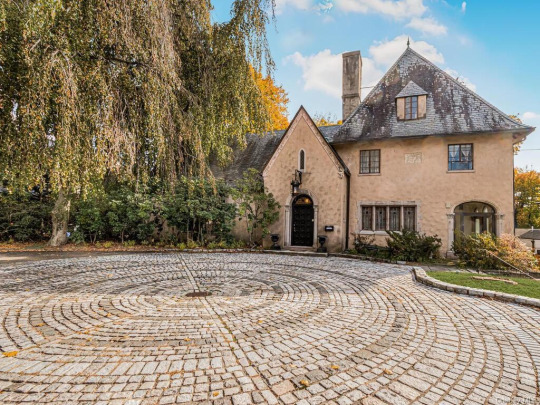
Gorgeous 1925 English Tudor style home in New Rochelle, New York is a foreclosure. It has 4bds, 4ba, $999K. But, the bank will only accept a buyer with cash or a renovation loan.


Look at this gorgeous woodwork. It is well worth the price, but there's not much reno to do. Why would you want to change this? The only thing I see is a dirty floor. It looks like it's been freshly painted.

I wish they would've taken a closeup of that magnificent fireplace. Look at the doors on the left and the leaded stained glass windows.


Look at this. A couple stairs up to the hallway, thru this beautiful shelving. Look at the artwork above the window, also.

I hesitate to call this amazing area a sun porch, b/c it's too sophisticated, but it could be one. It's enclosed, so it's not a loggia.

It has a typically English Tudor ceiling in this room and the wood paneling is so beautiful


The eat-in kitchen and cabinets are in good shape. Looks like there's a new dishwasher with the protective film still on.

What a great pantry.

I don't know what this room is, but it's nice and appears to have a closet and an outside door.


I wonder if the lift works.

Here's a nice large bedroom. Maybe it's the primary.

That bath needs some work. Weird toilet cubby.

Here's another nice room.

This one's a nice shape.

This bath is fine.


This is lovely up here. It's a finished attic, but has the duct work exposed.

This bath is perfectly fine, too. This house doesn't need a reno loan to completely modernize it, though, that would be a shame. Hope they don't paint the wood white and the walls gray.




The grounds need some clean up and this is the garage. Wow, look how fancy the floor was. The property measures .37 acre.
118 notes
·
View notes
Text
i tortured myself by reading the poto (1925) shooting script! there were good things and bad things and if i don't infodump about them i will explode
really long and rambly disclaimer: this isn't the original-original draft (which from my understanding is where the rosy hours of mazandaran sequence came from, but don't quote me on that), nor is it the same as the los angeles premiere cut (which from my understanding included the redemptive love ending for erik, which was apparently never scripted and got shot on the fly while they struggled to figure out how to end the film, But Again Do Not Quote Me). that said, you can see traces of the original script and some of the sequences lost with the los angeles premiere cut, and some of the choices made are... interesting!
long post so thoughts under the cut
complete list of items i am mad or at least disappointed we didn't get in some capacity:
the frame narrative. for some reason they had the story come from the files of m. faure instead of anyone actually involved in the narrative like christine or the daroga, but still. would have been cool
a close, honestly sweet relationship between joseph and simon buquet. if you're going to spend so much time focusing on joseph's death, maybe making us care about him is a good thing??? wild concept
la sorelli's knife <3 also just a role for her in general
erik using a trapdoor to spirit away cesar the horse. i don't know if they ever actually filmed this or what since it seems a little complicated, but the way it's written gives me major looney tunes vibes:

130-D ANOTHER PART OF CELLAR #5 OR #6 IF WE HAVE THE SET. MED. SHOT NEAR THE BIG OPERA HOUSE FORGE A groom currying a great white stallion while a Hercules of a smithy is preparing to put new shoes on the stallion. We plant the stallion fastened to a ring bolt in the stone wall by a strap and is parallel with the wall. The blacksmith is holding up the hoof of the great white stallion to measure a shoe, then he moves over to the forge and with his back to the horse pumps the bellows and sings to himself -- then a strange thing happens, a section of the wall and floor upon which the white stallion stands suddenly turns as if upon an axle and the white stallion vanishes leaving apparently the same wall floor and ring bolt - the smithy lifts the red hot shoe from the forge and prepares to hammer it. He casualy looks around toward the place where the horse was, gasps and drops the hammer. Then thinking perhaps one of the stablemen played a joke, he calls to him - they join him and he asks them about the horse.
so! much! daroga!!!! obviously he is the highlight to me. he gets so many more little scenes and i will say they get pretty repetitive after a while (he shows up, is mysterious for a paragraph, leaves, rinse & repeat), so i get why they changed things. but what i find interesting (and most agonizing to lose) about this particular version is that he's shown to be a pretty compassionate man, aloof but overall very kind and caring about others, even before we know what his deal is. he has a scene with raoul where he shoots him a look of "friendly compassion" while raoul is the exact opposite. it's... a wonderful characterization. what the fuck. also i get the sense that he regularly visits erik's house offscreen and maybe every time he's leaving/entering the cellars we are supposed to infer after the fact that he's paying erik a visit. MANY QUESTIONS. anyway this daroga is amazing and wonderful and i love him. we were robbed.
the "erik visible behind the mirror looking at christine" shot before ALW made it cool:

[181.] SEMI C.V. CHRISTINE ON COUCH Suddenly part of the mirror beind her becomes transparent, revealing the upper portion of the masked face.
mme valerius! she's christine's biological grandmother in this script rather than an adoptive mother, but waves hand. her relationship with christine is very sweet. definitely understand why they cut her, though, she shows up in one scene and isn't even mentioned anywhere else. but what she gets is nice
the cemetery at perros scene. it's SO atmospheric and probably was gorgeous-looking in black and white. unlike some of the scenes in this script we know they actually filmed it because we can see extant photos of it and UGH. UGH!!!!! MAD!!!!!!!

erik has a black mask. i get why they didn't do this one too because it wouldn't have shown up well in a black and white medium, but oh... it would have been nice...
the unmasking scene being partially colorized like the bal de masque. i am a sucker for silent film experimentation, this could have been neat
also the rat catcher (as a rat catcher vs. some random guy) having a colorized red scarf around his neck to make him look decapitated. very morbid. love it
the comic relief played by snitz edwards being the guy who touches red death. from a storytelling and filmmaking standpoint it makes sense (brings new characters into the original story, less actors to pay, etc.) and i'm honestly surprised this didn't make it to the final cut. also, erik's "don't touch me i am red death" warning is on his cloak like in the novel and that is one of my favorite book details so it delights me they were originally going to do it in the film
this erik line:

"WHAT HAVE YOU DONE WITH MY BAG? DON'T YOU KNOW THAT IS THE BAG OF LIFE AND DEATH!"
more understanding of/sympathy for erik from him expressing his desires in general
subjectivity in the torture scene. raoul imagines a forest fire and a lion in his delirium and maybe it wouldn't have worked but i love the stark contrast of that with the daroga's perspective of the frankly banal reality of the torture chamber immediately after (if only because it's a great daroga moment)
also the daroga being more levelheaded during the torture scene in general like in the book. i don't think they necessarily changed this in the final cut, but i do think they shortened the torture scene to a degree and used shots such that the daroga actively searching for a way out based on his preexisting knowledge is a little hard to infer, whereas on the page it is very obvious
this beautiful moment between christine and erik:

[535.] MED CLOSE UP ERICK AND CHRISTINE AMBER Christine gazes up at him earnestly and the picture is held for an instant. Erick realizes that the final moment is at hand and there is sense of terror in his manner. She asks him in a trembling voice: "DO YOU SWEAR TO ME THAT THE SCORPION IS THE ONE TO TURN?" BACK: For the first time Erick shows fear. In a hushed way he answers her: "YES... IF YOU WISH TO BE MY BRIDE." BACK: Quietly she turns from him. [536.] CLOSE UP CHRISTINE AMBER Without an instant's hesitation, but with thorough consciousness of what she is doing she turns the scorpion. [537.] A LONGER SHOT AMBER Erick walks toward her - a man crushed. Christine in this instant has become his master. Christine turns calmly to meet him.
but also i am extremely glad we didn't get these things:
a long, tedious history of the opera house. so much exposition that is mostly not interesting and only barely ties into the story. yawns. we dodged a bullet on this one
just raoul's entire starting characterization. the raoul we got is hardly amazing but wow. this guy is... literally everything raoul is not supposed to be: cool, suave, dashingly romantic, a womanizer. he's basically every 1920s he-man romantic lead and I Do Not Care For It. he gets better the further the script goes along/the closer the script follows the book, but woof. bad. BAD!
reveal of erik's face and the chandelier scene way too early. 35 pages into a 126 page script, or about 30 minutes in if we follow the 1 page = about 1 minute rule. that would have KILLED the suspense of erik's character and undercut the unmasking scene with christine later. and probably also messed with the pacing and sense of stakes. speaking of:
messy pacing. the most egregious offender of this is the beginning. the first fifty pages cover a single night, in which we: meet our characters, introduce the opera ghost concept, get even MORE boring exposition about the opera house, get three "wow the persian is so mysterious who is that guy" moments, set up the plot with erik wanting christine to sing, the murder of joseph buquet (also setting up his relationship with simon so we're sad about joseph biting the dust later), stealing cesare, the chandelier scene, an erik face reveal, raoul finding out about erik, and a whole bunch of other stuff that i can't even remember because it just comes nonstop all at once. the order is... weird, and the story does not benefit because there is just no dang moment to breathe and get to know any of these people. also HOW DOES ERIK HAVE TIME TO DO ALL THIS MAYHEM IN ONE NIGHT. HOW!!!!!!!!
erik's name is erick. for some reason??? it's like they couldn't decide between the eric and erik spellings and just decided to mash them together for... some reason...
subplot with philippe and his wife trying to send raoul to monaco. i do like giving philippe more to do to make his death is more meaningful, but this... is not the way. philippe calls the cops on raoul when he ends up becoming an army deserter, and i get the desire to add stakes, but I Do Not Care About Any Of This
the rising action for the climax is way too complicated. we do not need christine and raoul planning to leave after the bal de masque and then having their plans foiled because raoul gets thrown in prison, only for him to manipulate philippe into letting him out and then give christine a new plan to run away with her after the show, have erik find out about this and be mad because he was the one helped the cops catch raoul at the bal de masque (also he found out about raoul's prison escape and the new runaway plan because erik's apparently a peeping tom who watches christine get dressed in her dressing room, charming), and THEN get to erik kidnapping christine during the performance because apparently he is great at coming up with elaborate kidnapping schemes on the spot. we do not need it. we do not.
the daroga gets less important rather than more important at the end: this is something you can see in the extant versions, but it's especially frustrating in the shooting script because so much of his character was built up, but after the grasshopper and the scorpion sequence he just... exists. becomes one with the mob and that's it. at least in the extant cuts he gets to be the ONE person who ushers in the mob, semi-justifying his presence after he guides raoul to erik's house. in this script he ushers the mob in with simon buquet and raoul (because yes, the mob ending apparently existed in some form dating back to this script if not earlier--UGH!!!!!), which doesn't make the daroga feel really useful or necessary as a character at the end. also he and erik don't even get one scene together in the entire script, which is flabbergasting to me because the trajectory of the story is clearly steering toward some kind of confrontation between them at the end, but nope. my guess this is all a casualty of the constant ending rewrites and the daroga's character being one of the more difficult characters to adapt to 1920s hollywood movie standards, but i'm still mad. this daroga was so good and even during pre-production was getting done so dirty
philippe.... lives????? how did that even happen, what. just what. he went and was drowned but sike! he's alive! what the fuck.
#screaming into the void#poto#poto 1925#erik the phantom#lon chaney erik#christine daae#raoul de chagny#ledoux#the daroga#nadir khan#very mad that i can't find a copy of the original-original script anywhere. or even the script notes because WOW it sounds interesting#time to crawl through film studies archives i guess. if it's available for academic use i will find it#scratching at the walls. give me a poto script with this good daroga characterization and semi-sympathetic approach to erik please!
19 notes
·
View notes
Text
I Feel You Linger In the Air
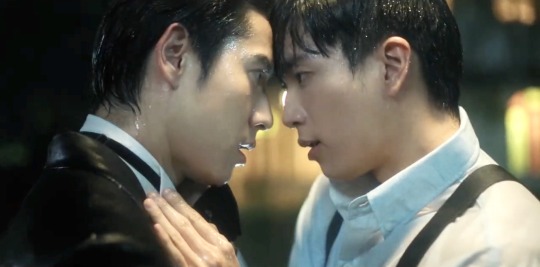
You ready for this?
The quickest of quick thoughts: I loved this show and hated the ending, but not for the reason you think.
This is gonna be one of my big meta beast-sized posts, skip to the end for the final review.
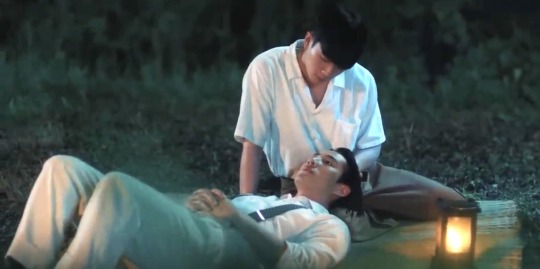
Some Historical Context for I Feel You Linger In The Air - Thailand 1925-1932
I love history and so here's some info that any Thai watcher would likely know, but the rest of us might not... ready?
The Historical Stage:
Burma (now Myanmar) to the west is occupied by the British.
The French hold Vietnam to the east.
Everyone is bickering over what would become Cambodia & Laos.
China occasionally gets involved from the North (also, lots of immigrants from China at this time accounting for a large percentage of the merchant/middle class)
Eventually, Japan would invade during WWII.
In part, The Kingdom of Siam was kept a "neutral" party because none of the surrounding colonial powers wanted to risk offending any of the other players in the area.
Siam re-negotiated sovereignty in 1920 (from USA) and in 1925 (from France & Britain). But during the time of this show (late 1929) it was back to it's customary type-rope balancing act of extreme diplomacy with the allied western colonial powers that surrounded it.
Recognizing that Thailand was never colonized (although it was invaded), it's boarders were constantly nibbled at and it was "ambassador-occupied" off and on by westerners whose military backing and exploitive business concerns simply outmatched the monarchy, especially in the technology department (as well as by reputation on the global stage at the time).
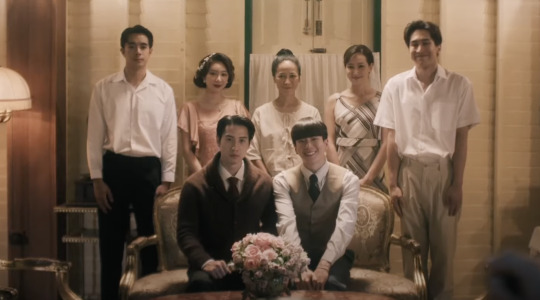
In other words, the farang in this show (James & Robert) were always gonna be both the baddies and the power players of the narrative. (Farang is the Thai word for non-Thai's of European descent, the word means guava.)
The king of Siam at the time (Vajiravudh AKA Rama VI) was initially somewhat popular but also regarded as overly extravagant since Siam had been hit by a major postwar recession in 1919. It should also be noted that King Vajiravudh had no son because he was most likely gay (which at the time did not much concern the Siamese popular opinion, except that it undermined the stability of the monarchy leaving it without an heir).
He "died suddenly" in 1925 (age 44) with the monarchy weakened and succession handed off to his younger brother.
In 1932 a small circle of the rising bourgeoisie (all of whom had studied in Europe, mostly Paris), supported by some military, seized power from the monarchy in a practically nonviolent Siamese Revolution installing a constitutional monarchy. This is mentioned in IFYLITA in the last few episodes but did not (apparently) appear in the original novel.

Siam would then go through:
dictatorship,
WWII,
Japanese invasion,
Allied occupation,
democratic elections,
military junta,
the Indochina wars,
communist insurgency,
more democracy and popularization movements,
multiple coups,
more junta,
more monarchy,
eventually leading us to the somewhat chaotic insanity of Thai politics we have today. (Which is, frankly, a mix of monarchy, junta, democracy, egocentric popularism, and bribery.)
The Filming of I Fell You Linger in the Air
The director if this show, Tee Bundit (Hidden Agenda, Step by Step, Lovely Writer, TharnType), has never particularly impressed or offended me as a director. I would have called him simply "workmanlike" in execution: not offensive, serviceable.
So much so that I spent some time hunting for info on IFYLITA's cinematographer (who remains uncredited on MDL) because this one, of all Tee's pantheon, is ultra stylish. It, frankly, felt too good for him.

Specifically, there is a repeated visual motif in intimacy scenes of either Yai or Jom being filmed from behind a screen/drape/curtain making them seem more translucent, like a ghost or spirit. While the other half of the pair is filmed with sharp clarity. In the first half of the series this is more likely to be Yai (an unknown and mysterious element), as the show progresses, it's more likely to be Jom (the person outside of place and time, destined to vanish all together). This cleverly conveys story, tension, and foreshadow (future shadow?)
Occasionally we shift over so they both become obscured and then clear again.
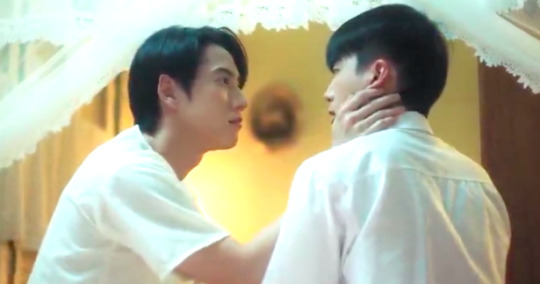
This stylized version of dirty framing and filters is used to foreshadow and then constantly remind us about that Jom slipped (and is slipping) through time and the disconnect that causes to his sense of reality and purpose, and to his burgeoning relationship.
For example, the scene where Yai is drunk and asleep in his bed. The first time Jom is sitting in a chair drawing him. Yai is blurry behind the screen while Jom is solid and sharp.
This filming technique combined with dirty and peekaboo framing is being used to give the watchers the impression of looking at something we maybe shouldn't, like we are being creepy and intruding on their private time. After all, they can see EACH OTHER clearly, it's only us who have the visual impairment.

This gives us a sense of doom and discomfort and slight sensation that we shouldn't be there. We shouldn't be watching. But ALSO that we too are outside of time, filtered by the future.
In other words his sense of displacement is being used to trigger ours visually.
It's all quite clever.
It's both beautiful and atmospheric and discomforting and touch stressful. Meaning that it is ALSO a visual vehicle to drive narrative tension. As effective as scary music, perhaps more so in this show (since I personally found the musical motifs and refrains somewhat overused.)

Linguistic corner
The word for reflection and shadow is the same in Thai.
Note on the por/phor/phô honorific in Thai
I have not encountered it before in BL. I am indebted to @embraceyourfandom for the following information;
Phô is a paternal honorific, luang phô is used for respected monks. It basically means father. And is oft seen as male honorific for village elders. It's also used as a male prefix in the names of several occupations like:
พ่อครัว phô khrua (khrúa= kitchen -> chef)
พ่อค้า phô khá (khá= trade -> merchant)
พ่อมด phô mót (mót= person of occult knowledge -> wizard)
พ่อบ้าน phô bân (bân =house -> butler) - most relevant
So, Yai's use is probubly foreshadowing that Jom will be a butler for his house, and is primitively referring to him with this title.
All that said, phô can also be used by a "man who is older/higher on hierarchy to refer to a younger/lower on hierarchy man with intimacy and/or affection."
I think all this has to do with Jom's demonstration of education. Yai figured out early on that one of the reasons Jom doesn't belong and cannot fit in with the servants is that he is more educated than a peasant (of this time period), which for Yai adds up to him being originally from a higher status and possibly wealthy family, especially since Jom speaks English and has travelled (he has a non-northern accent).
There is very little Thai middle class at the beginning of the 1920s since trade is being dominated/dictated by the West, or Chinese merchant operations, and Siam is a monarchy. So for a nationalize Thai citizen educated means military, landed gentry with trade operations (like Yai), royal/political/diplomatic connections, or... none of the above. This changes, especially in the south, throughout this decade (as it did in other parts of the world). So there is a rising bourgeoisie going on in the background but it's not that obvious in Chang Mai at this time.
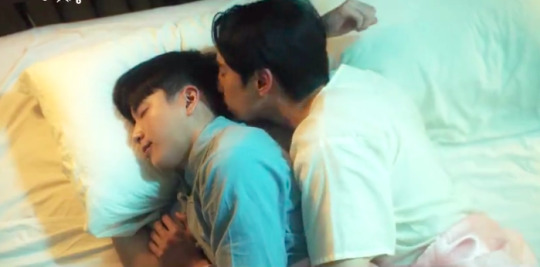
What Jom's educated lack of status means to Yai is that Jom's family either got wiped out or politically disenfranchised possibly as part of the 1912 attempted coups (or even WWI)? This would be mystifying for Yai because Jom doesn't act like he comes from a military family at all. So his background and status is very confusing for Yai, but Yai does know one thing...
Jom is NOT lower class by the standards of Yai's temporal worldview and existence.
For a young man to be educated and yet entirely alone is very dangerous and suspicious. Also, let's be clear, Jom doesn't look or act like a laborer. He red flags "cultured" all over the place.
Yai is paternalistic and caring towards Jom out the gate because Yai has a big ol'crush but also because he recognizes "his own" is trying to survive while isolated and scared.
Yai wants to rescue Jom. Yai is an ineffectual 20 year old gay intellectual. But poor thing sure tries.
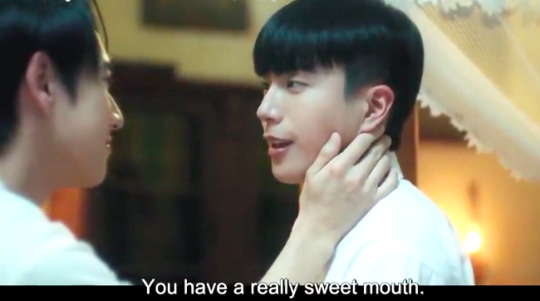

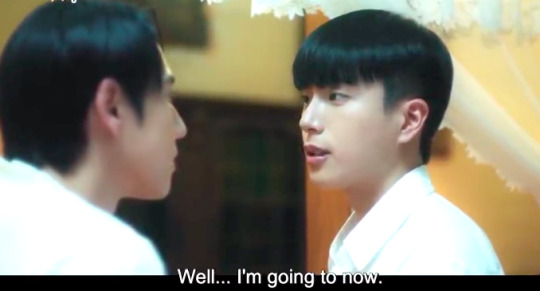
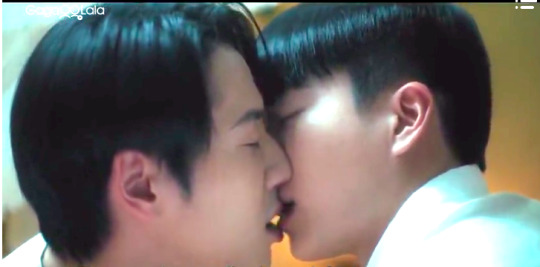
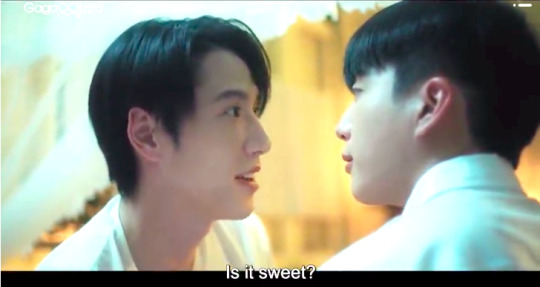
Let's Talk About How I Felt About I Feel You Linger in the Air
The historical aspect was great.
I adore historical romances and we almost never get them in BL. I was always gonna be biased towards this show. (As indeed I am towards Nobleman Ryu's Wedding, Tinted with You, and To Sir With Love.) Aside from some classic Thai BL production issues (less than normal, this is very high production value for Thailand) and my issues around the sound track and repetitive repriens (which frankly were more noticeable because I binged the last half) I have no complaints on that score (heh heh).
The surrounding support cast were all quite good and we even got us some lesbians!
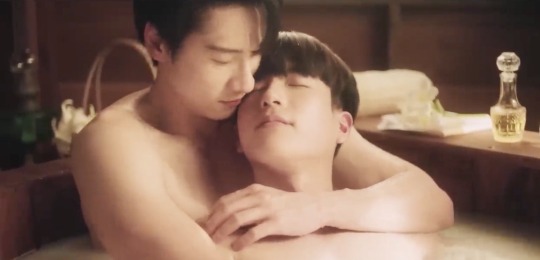
The emotional and narrative tensions were excellent.
Any issues I had with pacing came from focus on characters that didn't interest me, but probubly did interest others. I wasn’t wild or particularly interested in the family drama or the side characters/couples, but they were necessary to make this a fully fleshed story with historical context and to give Yai much needed characterization. Also this use of a ensemble cast is very close to Thailand's lakorn heart, even thought this one had way less scenery chewing ludicrous soapy drama (thank heavens).
I was delighted that external threat, stressors, and conflict drove this plot. That's refreshing in BL.
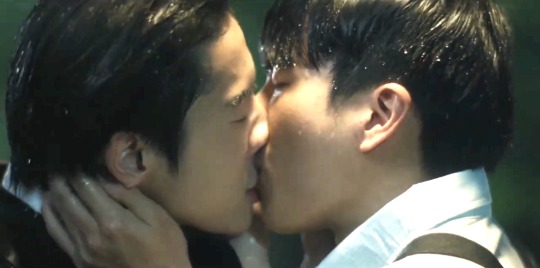
I have no arguments with the chemistry and kisses and sex scenes were tasteful and lovely, occasionally even heart-wrenching, and it's nice to see Thailand especially use physical intimacy to drive plot, and not the other way around.
I love historicals partly because every tiny touch can have such lingering significance, they're very elegant in their chaste physicality. This show didn't need to move into higher heat, but I'm grateful it did because even that was very well done. Thai BLs can often feel clumsy around intimacy, but not this one.
The final sex scene before Jom and Yai separate forever utilizes the ubiquitous director's-favorite-romantic-moments-flashbacks (required of all Asian romance dramas) but with acceleration and tension driven by the noises of sex, which I've never seen/heard done before. In other words: climax of sex = climax of the romance story, I see what you did there, Tee. Clever. Very clever. Bit on the nose… erm… on the… well you know what I mean.
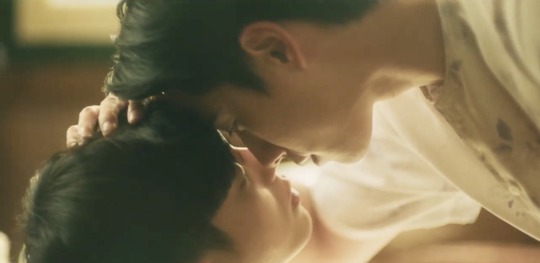
Like all Thai BLs this wasn’t perfect, but for me this is as close as Thai BL gets to high quality romance and that’s what I want the most from my drama watching experience (if not necessarily my Thai BL experience).
But... and you knew the but was coming didn't you?
I absolutely hated the ending.
It wasn't sad, don't worry, but it also wasn't good.
There is a long drawn out separations sequence and then Jom returns to the present, drowning from a car accident. Jom is "rescued" by an moustachioed iteration of Yai from the distant past (who we met once before) and then wakes in hospital. Some time later, Jom returns to the house in Chang Mai where Yai turns up and they reunite.

The end.
There is a stinger featuring Jom once more hurled back in time, only further, meeting the warrior mustache Yai once more.

Okay, that's all I knew and all I saw.
Confused? So was I.
If this had been a regular time travel romance: Yai would have been the EMT or doctor attending Jom when he woke up and their "this time period" romance would commence. With either shared memories, or not.
Had this been set up for audience comprehension in line with the original novel, we should have had flashbacks from both Present Yai (he's not the same one, as it turns out) and deep-past Moustache Yai interwoven throughout the series. Preferably with some focus on Present Yai's quest for reunion with Present Jom AND Present Yai's own experience with visions and memory of his past lives.
A full explanation of the ending is here. This explanation of the 3 different Yais makes me like our ending more. But I shouldn't need to read Cliff's notes from some random y-novel reading fan on Tumblr to understand what's going on in a series!
There is supposedly a special happening with Jom + Present Yai.
There was unquestionably a failure in adaptation in the finale of this show.
As a fan and watcher, what I actually felt was deeply confused and hurt.
I also felt that this was a disingenuous un-earned throw away happy ending, since I had no idea who this new Present Yai was and no investment in his character. I simply didn't believe he was the same Yai (Bright is too good an actor, he was clearly a different older personality).
So the fact remains that past Yai, our Yai, the 20 year old boy we grew to understand and love, is abandoned in the past to suffer alone for the rest of his life. And THAT is an unhappy ending for one half of my beloved pair. Yes Jom gets a new Yai in the present day, but it's not the same Yai. They have no developed relationship, and Jom is doomed to leave even this new Yai and slide into the past once more. That's barely even happy for now for Jom's character.
As a result of my deep sadness for 20-year-old Yai in particular, I'm not going to be able to rewatch this show. The whole thing was rendered not just confusing but the opposite of comforting by the final 15 minutes. I'm tempted to dock it two whole points - one for the ending and the other for the lack of rewatch potential.
But the first 11.5 eps were SO GOOD.
This is one of the only times where I am actually hoping for a second season, while simultaneously being wary of the screen writing and production team's capacity to give us a satisfying one.
Industry wise? I honestly don't think we can hope too hard for a full season 2. This was an expensive show with flawed/limited distribution and little sponsorship. I don't see how they'll get funding for a second season. Unless we see this show up on like Netflix or Viki, I urge you not to hope too hard and be disappointed.

In all honestly?
I started typing up this blog post thinking Thailand was finally, after 5 years, going to earn another 10/10 from me but I just can't in good conscious give it that. It's been days and I'm still upset about that last episode.
And Now My Quick Pitch Review
I truly loved this time travel romance. IFYLITA is an exquisite BL, from filming techniques to narrative framework (much like Until We Meet Again). Steeped in history and family drama it edges into lakorn (but no as much as To Sir With Love and with way less scenery chewing). This is an elegant and classy BL... from Thailand which normally doesn't even try for classy. The main couple (both as a pair and individuals) were excellent, particularly Bright (Yai) whose eye-work acting style is a personal favorite of mine. Pity about the ending. Oh it wasn’t that sad but it wasn’t good either. This show should easily have earned a 10 from me except that it fumbled the… erm… balls. Argh. Whatever. 9/10
(source)
This post is also in My Drama List as a review.
#I Fell You Linger in the Air#Thai BL#BL review#I have LOTS of thoughts#Filming analysis#historical context#lanaguage and lingsuitic use#BrightNonkul#YaiJom#Tee Bundit
140 notes
·
View notes
Text
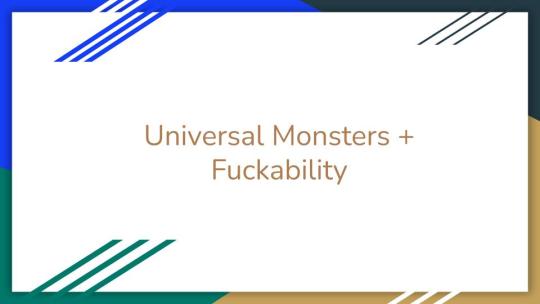
Universal Monsters + Fuckability

Qualifications (choosing movies)
I have seen the movie.
Characters listed as part of the Universal Monsters lineup (Phantom of the Opera from 1925 for example is not included.)
Personality and events of film considered just as much as physical attractiveness.
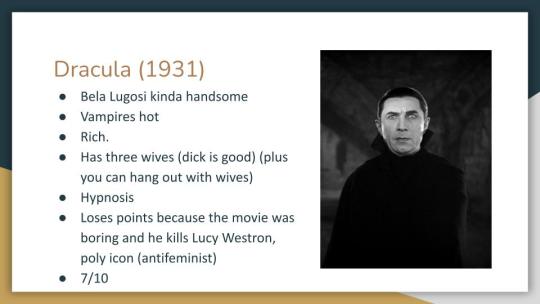
[ID: Picture of Bela Lugosi as Dracula, dressed in black clothes and a cape, staring at the camera with an annoyed expression. His face is slightly in the shadows. End id]
Dracula (1931)
Bela Lugosi kinda handsome
Vampires hot
Rich.
Has three wives (dick is good) (plus you can hang out with wives)
Hypnosis
Loses points because the movie was boring and he kills Lucy Westron, poly icon (antifeminist)
7/10
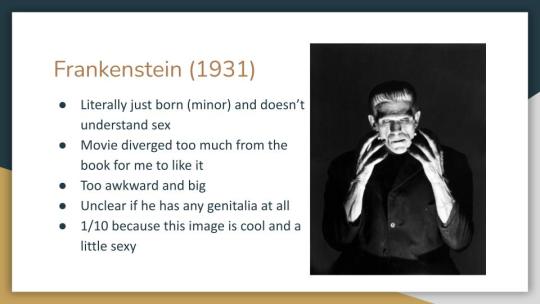
[ID: image of Boris Karloff as Frankenstein, holding his hands to his face, looking offscreen and with a disturbed expression. The lighting only lights up his face. End ID]
Frankenstein (1931)
Literally just born (minor) and doesn’t understand sex
Movie diverged too much from the book for me to like it
Too awkward and big
Unclear if he has any genitalia at all
1/10 because this image is cool and a little sexy
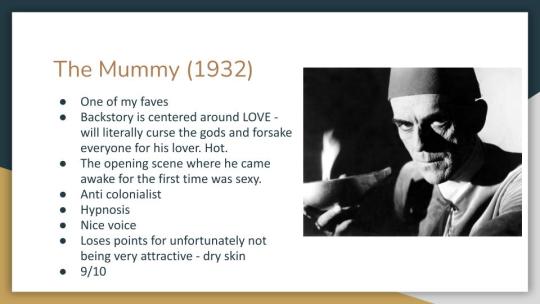
[ID: Boris Karloff as Imhotep the mummy. His skin is dried and sunken in. He's glaring at something offscreen. He's dressed in a high collar brown shirt and a cap that covers the top of his head. End ID]
The Mummy (1932)
One of my faves
Backstory is centered around LOVE - will literally curse the gods and forsake everyone for his lover. Hot.
The opening scene where he came awake for the first time was sexy.
Anti colonialist
Hypnosis
Nice voice
Loses points for unfortunately not being very attractive - dry skin
9/10
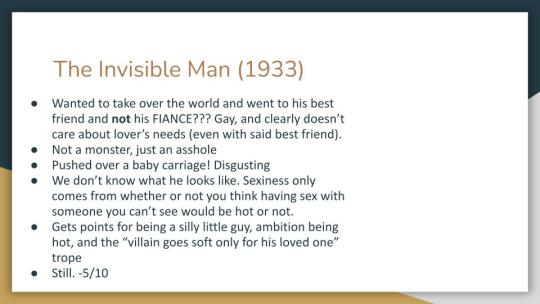
[No image for this slide]
The Invisible Man (1933)
Wanted to take over the world and went to his best friend and not his FIANCE??? Gay, and clearly doesn’t care about lover’s needs (even with said best friend).
Not a monster, just an asshole
Pushed over a baby carriage! Disgusting
We don’t know what he looks like. Sexiness only comes from whether or not you think having sex with someone you can’t see would be hot or not.
Gets points for being a silly little guy, ambition being hot, and the “villain goes soft only for his loved one” trope
Still. -5/10
Bride of Frankenstein (1935)
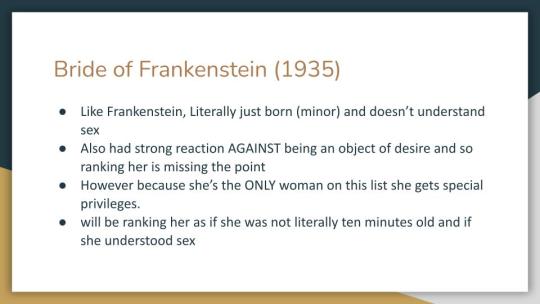
Like Frankenstein, Literally just born (minor) and doesn’t understand sex
Also had strong reaction AGAINST being an object of desire and so ranking her is missing the point
However because she’s the ONLY woman on this list she gets special privileges.
will be ranking her as if she was not literally ten minutes old and if she understood sex
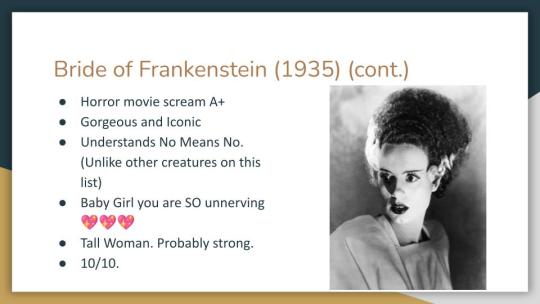
[ID: Elsa Lanchester as the bride of Frankenstein. The lighting of the image is very bright, so you can see her whole upper body with very few shadows. She's staring at something offscreen with a curious but frightened expression. She wears white robes, and her hair is black with a white streak up the sides, in a beehive style. End ID]
Bride of Frankenstein (1935) (cont.)
Horror movie scream A+
Gorgeous and Iconic
Understands No Means No. (Unlike other creatures on this list)
Baby Girl you are SO unnerving 💖💖💖
Tall Woman. Probably strong.
10/10.

[ID: Two images of the wolf man. One is the wolf man as the wolf man, standing in thr woods, his face covered in fur, his hands furry and clawed, looking panicked. The second is Lon Cheney Jr. as Larry Talbot, a white man with short dark hair slicked back, dressed in a suit with a plaid tie, with a stressed out look on his face. End ID]
The Wolf Man (1941)
This movie just makes me sad. Larry Talbot is a tragic figure.
But he’s also kind of a stalker (spies on woman)
Only a monster half of the time
Wolf form isn’t attractive. (human form okay.)
No sense of control.
Not even a little okay with his murders. Too pathetic and sad.
2/10
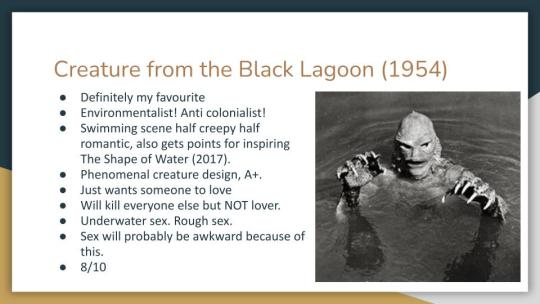
[ID: Image of the creature from the black lagoon, a creature the size of a man covered in scaley and amphibian-like skin with a fish-like face. He's mostly submerged in water, only his head and finned hands with sharp claws poking out of the water. End ID]
The Creature From The Black Lagoon (1954)
Definitely my favourite
Environmentalist! Anti colonialist!
Swimming scene half creepy half romantic, also gets points for inspiring The Shape of Water (2017).
Phenomenal creature design, A+.
Just wants someone to love
Will kill everyone else but NOT lover.
Underwater sex. Rough sex.
Sex will probably be awkward because of this.
8/10

[ID: profile of the Bride of Frankenstein. Her head is tiled up and her eyes are mostly closed.]
Congratulations to our winner! Runner ups, The Mummy and the Creature From the Black Lagoon.
#as promised#universal monsters#dracula#frankenstein#the mummy#the invisible man#bride of Frankenstein#the wolf man#the creature from the black lagoon#creature from the black lagoon#dracula 1931#frankenstein 1931#the mummy 1932#imhotep#the invisible man 1933#jack griffin#bride of frankenstein 1935#the wolf man 1941#larry talbot#creature from the black lagoon 1954#i'm saying stuff#i'm making stuff
187 notes
·
View notes
Note
Stupid question, not sure if it’s been asked before, but: do you think Armand actually likes theatre/fine art or does he just adopt whatever his partner is into so deeply he has no clue it isn’t (or wouldn’t be) his bag if not for said partner?
That's not a stupid question at all, anon, and it definitely hasn't been asked of me before. Mmm, my gut instinct is to say that I think his interest in visual art is probably more authentic than his interest in theatre? There's that little beat in 2.06 where they're rehearsing the fake play, and Armand's a lot more attached to the projection art as a part of the show than seemingly everyone else, which feels fairly unique given how rarely he expresses that sort of personal preference. It actually could be reflective of his interest in technology too though, which is canonical to the books.
Film and projection art only really started to become a part of theatre in the 1910s and 1920s - probably the most famous magician of all time, Harry Houdini, was actually a very early adopter of that in around 1908/1909, and he was hugely into technology as a performing artist generally (I actually randomly know a bit about this as I've been researching/working on a creative project for a couple of years now about Houdini's 1910 tour of Australia where he brought this tech with him to the Melbourne vaudeville and variety scene [and hilariously became the first person to fly a plane across Australian soil, because he was also obsessed with flight technology, and also Australia is insane], and also just have a general interest in very early cinema).
We don't really know the show's timeline yet in terms of Lestat leaving Paris, nor if the show will follow the book in having Nicki be the one who really founds the theatre, but assuming Armand's at least being honest about the timeline, if Lestat left Paris around the turn of the 19th Century, it will be long before that sort of film/projection art existed in theatre. I think the 2.03 flashbacks were partially about showing us how much the theatre itself has declined / hit hard times / been impacted by the French Revolution and two World Wars, but still - - that sort of projection technology didn't exist when Lestat was performing in Paris, and so someone introduced it. The reality is too that it was innovative in the 1910s and 1920s (it really hit peak popularity - along with vaudeville and variety theatre, which is what the Theatres des Vampires are doing by the time Claudia and Louis meet them - in about 1925), and I think there's a pretty logical read there that that may have been Armand's doing.
It kind of works I think in terms of the creative friction within the troupe too, because both that sort of projection and variety theatre wasn't really in fashion by the 1940s when Louis and Claudia meet them. Armand feeling it's vital to their work and Santiago being over it (especially with Santiago being younger, and having wanted to be a serious actor) actually makes a lot of sense timeline-wise, and I think could be interpreted as an acknowledgement that the sort of theatre they're making is dated (cinema basically killed this type of theatre by the late 1920s, and that sort of projection art played a role, because with it came, well, film). The fact that Armand as the theatre director hasn't really kept up with theatre as an artform I think lends itself to him not being that into it personally / it being something he adopts because Lestat loves it, and he deifies Lestat.
If he is the one who adopted the projection art, and is the one still attached to it in the 1940s, I can see that indicating more that his interest in art and technology is perhaps a bit more authentic and true to who he is? I'm not going to be able to find it now (and don't have the means to check the ep at the minute, just because I'm not at home), but in the ep where Armand and Louis are contemplating what to replace the Francis Bacon triptych with in the Dubai loft, Armand suggests something that's extremely different to everything we've seen / that Louis likes, which I think is indicative of him having his own taste when it comes to fine art at the very least, but how much that might have been informed by Marius is anyone's guess right now.
But I actually, delightfully, think the interest in technology is all him, and I think you could make a case that Armand probably brought that projection technology to the theatre in the 1910s when it was genuinely a pretty innovative new invention to play with. It's interesting to think about!
#i do think the theatre being dated is sort of a wink at the fact that the troupe is entirely out of time#plus the dual trauma of wwi and wwii for paris#but yeah!#fascinating!#i'm so curious what they do with armand and nicki next season and how much we get to see of it?#lestat being interviewed instead of narrating really does open the story up so much#in that sense#i hope they're deranged about each other while being deranged about lestat <3#armand asks#iwtv asks
7 notes
·
View notes
Text










RONALD COLMAN and VILMA BÁNKY
1-3. The Dark Angel (1925) 4. The Winning of Barbara Worth (1926) 5. The Night of Love (1927) 6-8. The Magic Flame (1927) 9-10. Two Lovers (1928)
#yeag#i love them. so much. and had to make a tribute#i spent a lot of time agonising over what pictures to choose but basically i tried to show their range and variety#can you believe they didnt win the hotvintagepoll???? they were so beautiful and their chemistry was insane!!!!!#they could truly do it all! wwi drama? western? kidnapping? circus romance? revenge plot? arranged marriage? you name it!!!#he wants to spare her the pain of loving him she wants to revenge his death they hate each other they save each other theyre in love they!!#ronald colman#vilma bánky#vilma banky#the dark angel#the dark angel 1925#the winning of barbara worth#the night of love#the night of love 1927#the magic flame#two lovers#two lovers 1928#films#photography#my post
10 notes
·
View notes
Note
It’s kind of surprising sometimes that this story is still popular considering what the original story of the book is about. Why is that? Do you think the story still would’ve been as well-known without the musical, or if it had been written/performed with darker vibes closer to the book?
The ALW musical, definitely the musical.
I mean, all you need to do is look at the history of adaptations before the musical, and how much cultural staying power they had, and then look at everything after the musical. Phantom had a lot of adaptations before the musical, that is true, but none of them really settled into the cultural mainstream the way the musical did, with the possible exception of the 1925 film (and I think that was more because of its strong visuals and technical skills behind the scenes as well as Lon Chaney's iconic performance).
So without the musical, no, I don't think the story would have been as well-known, and I also think the public view of it might have been fairly different, perhaps seeing it more as a straight horror or suspense story rather than the Gothic romance we see it as today. Again, for proof, look at the various and most well-known adaptations pre-ALW, which tended to make a number of changes to the story and, even if they kept the Phantom sympathetic, went for more of a suspense or even horror vibe.
As for whether the musical would have such staying power if it had been darker... I mean, first, I'm not sure if ALW would even go that route (his musicals can have mature themes but I would not characterize most of them as "dark"). But my thought is that no, it would likely not have been as successful as it is now. I see this alternative version as having a fairly decent run on the West End and maybe Broadway and then getting the occasional international production, but nothing on the scale of what it is now.
Because I think what ALW did with the musical is that he brought out all those themes of unrequited love and melodramatic romance and dark, forbidden passion, which are all present in the book but subtler, and made it overt, then added a lot of earworm-y tunes to it. Combine that with Maria Bjornson's incredible design and Hal Prince's excellent direction, which emphasized even more the simmering sensuality of the main characters, and you have a musical that appeals to most audiences and is also understandable across many different cultures without any need to tweak the story.
Because at the end of the day, darker stories with more horror and suspense / thriller / mystery vibes are a little more niche. They are popular, I enjoy them tons, but I'm aware enough to know that not everyone else does, and not everyone is always in the right mind space to appreciate them. But a grand, sweeping tale of passion and unfulfilled love with a broodingly sympathetic male lead and massive spectacle? That's bringing Phantom into the mainstream, because most everyone can understand that.
16 notes
·
View notes
Text
The New Scooby Doo Movies S2 E5-8
5. The Exterminator
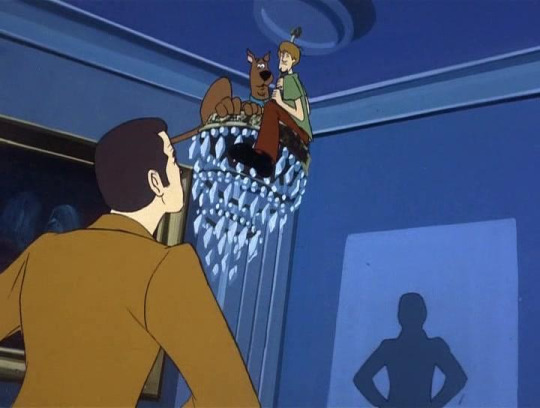
This episode follows the gang aiding Don Adams to exterminate bugs inside the house of a famous director, however, they are soon met with a series of strange occurrences.
I think this episode is positively okay!
Don Adams as our guest works for this! Much like Tim Conway in the previous episode, these characters seemingly aren’t their celebrity counterparts, more so, played by their celebrities. Don plays a very persistent exterminator that I often found funny!
From what I understand, this episode is heavily influenced by the juvenile detective novel, The Secret of Terror Castle, written by Robert Arthur, Jr. Besides that, the episode is also seemingly inspired by a series of other influences, mostly early movies fitting with the house owner's job as a silent film director. Even his name, Lin Chaney, is an allusion to Lon Chaney, maybe best known for the silent horror movies Hunchback of Notre Dame (1923) and The Phantom of the Opera (1925).

Once again, we see an episode use a slew of villains, although I don’t mind it too much here! It fits into the idea of this character as a movie star. To quickly rattle through them, there’s a handful inspired by early horror movies, these being the Wolfman, Frankenstein’s Monster and Mr. Hyde. As we will come to see, the majority of these monsters are reused assets, or at least, very closely resemble old characters. All three of these appear like their earlier counterparts.
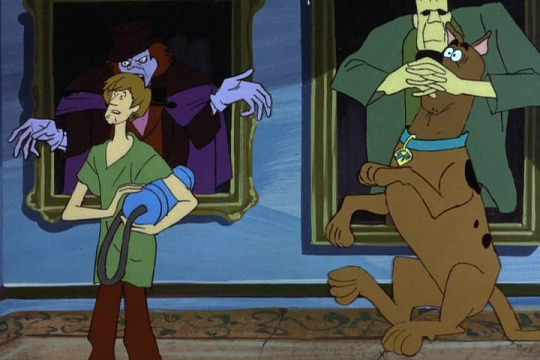
The other monsters are the Cat Creature, Bird Creature, Sea Monster and Creepy Man. All of these characters resemble more basic monster ideas, the first three anthropomorphic animals, the final a creepy man. The Sea Monster is a recolour of a prop that appears in The Dynamic Scooby-Doo Affair, the first Batman crossover episode, and the Creepy Man is a recolour of Swampy Pete from The Ghostly Creep from the Deep.
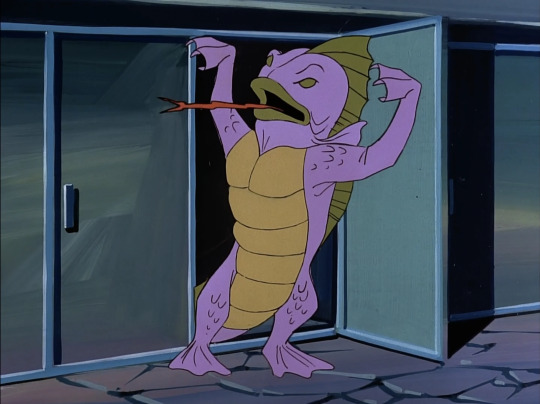
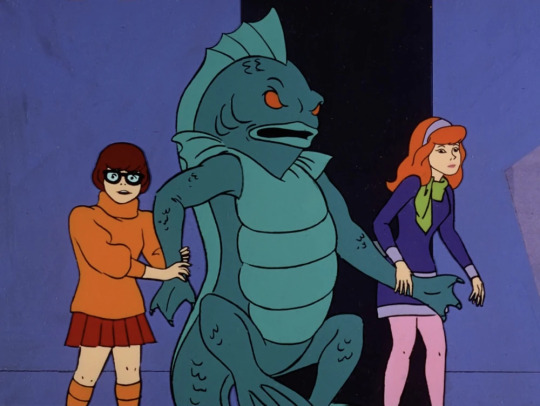
However, as far as I can tell, the Cat and Bird Creature are completely unique designs, and both end up being my favourites. The Bird Creature has a spiky design paired with an olive green palette, he resembles a knight in his clothing, although he sits as a bust on the wall. Meanwhile the Cat Creature is almost Yeti like in design, he has brown fur and a large body, but his unique appearance allows him to stand out amongst this flurry of recolours, some more egregious than others.
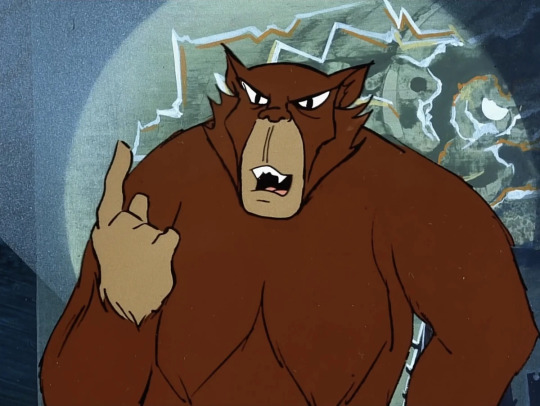
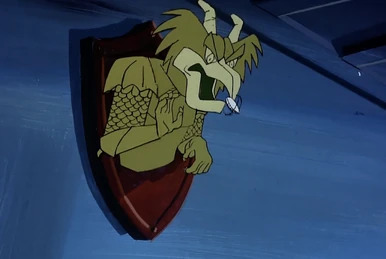
Besides these main points, I did love all the bug shenanigans in this episode, particularly the soldier ants and squirt bug. Stuff like this always makes me giggle.
6. Weird Winds of Winona
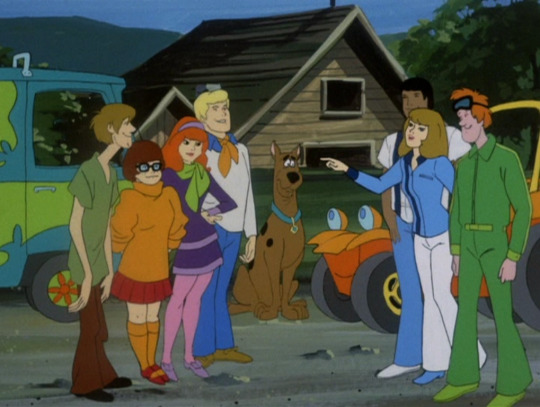
As my review of the previous four episodes of this season indicated, I am a big fan of episodes that use Hanna Barbera characters as the guest stars. Therefore, this episode, the final one to do so, already takes bonus points.
This episode follows the gang and Speed Buggy’s gang as they attempt to solve the mystery of powerful winds blowing in the titular Winona, which has driven everyone from it.
The Speed Bugs (as I have just learnt their gang is called) consists of Speed Buggy, a yellow car, Debbie, Mark and Tinker. Of course, the stand out of this group is their “Scooby Doo”, Speed Buggy, the car is simply brimming with personality, he stands out against his inspiration where a character like Mark doesn’t. Also, his animation is weirdly gorgeous, like my God they drew this car in such a cool way, every movement accentuates his personality, his speech is perfect giving him the effect of a sputtering exhaust, oh my do I love him! Tinker is a fun character too, he acts almost as a Shaggy, which is a pattern for these shows that are inspired by Scooby Doo - most of the time, they include a Scooby and Shaggy.

To delve into this formula a bit more clearly, the popularity of Scooby Doo led Hanna Barbera to use this show as a template. Roughly, they would take a group of teenagers and give them a “mascot”, they would usually solve mysteries, but this is not a requirement. Examples include The Funky Phantom, Clue Club, JabberJaw, Captain Caveman and the Teen Angels, Fangface and Josie and the Pusscats. This is only naming a few. I have a very specific interest in this era - most of the aforementioned cartoons didn’t last long, however, they are all so interesting to me. Frequently, they would also omit a Velma style character, blending her personality type into the other members of the gangs.
Speed Buggy has become a fairly recurring character to appear in Scooby media - I think most Scooby fans will recognise him from Mystery Incorporated Episode Fourteen, where he appears alongside a handful of the other Scooby inspired shows characters. Although, he also has appeared elsewhere - he appeared in the Hanna Barbera Laff-a-Lympics on the Scoobie Doobies team, he also appears in the Scooby Doo! comic (issue 50) Big House Brouhaha (which is filled to the brim with cameos) and he also cameos in the most recent series Guess Who. This is not to mention that he also appears in the more recent show Jellystone!, which from what I understand, is a show that brings together a host of Hanna Barbera characters, I believe he is a fairly minor character.
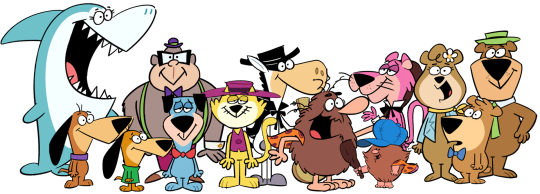
The interactions between the characters are what makes this episode enjoyable, the rest is somewhat whatever, but wow do these characters bounce off one another in a fun way! This episode is far from perfect, it suffers from the usual pitfalls of New Movies, yet, these bright lights are always appreciated.
The villains, the Windmakers, sure do appear! They’re very bland “cult” members. Their designs are hooded men, they blend in my mind with the hooded man from The Dynamic Scooby Doo Affair, although I guess I’m happy they didn’t use a simple recolor here?
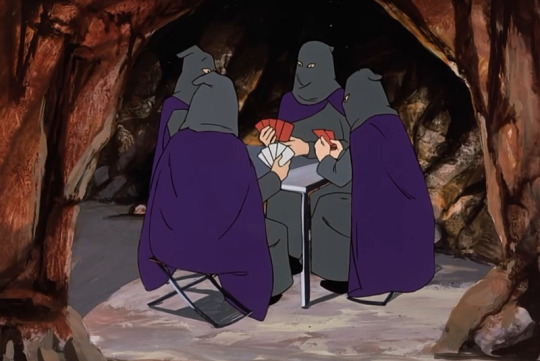
When the episode fixates on just placing these two groups in a single desolate location, I’m loving it, but when the meandering and dull story takes over, I lose a lot of my interest.
7. The Haunted Candy Factory
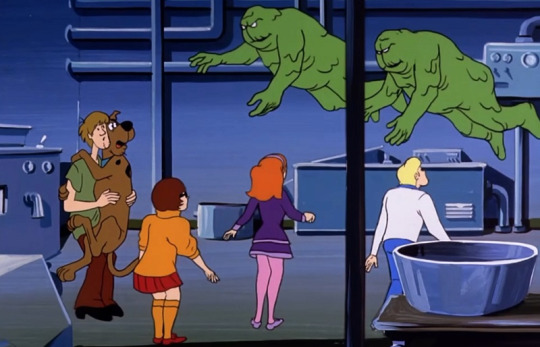
We follow the gang as they investigate a pair of green blobs that are terrorising a sweet factory. I actually love this location a lot, it feels like such a perfect eerie place to drop the gang, even if it puts Shaggy and Scooby in a series of very obvious gags - I enjoy them regardless!
Our guest for this episode is Cass Elliot, maybe best known for being in the band The Mama’s and Papa’s, although she also five very successful solo albums. Unfortunately, she passed away not long after this episode aired, partly because she partook in a lot of extreme diets that were popularised in the 70s (the grapefruit diet is mentioned by name) which gives a very tragic feeling to this episode given their frequent use of jokes about her weight.
The villains of this episode are The Green Glob Ghosts, who are such boring designs, they’re dark green blobs, there’s not much more to them. However, they have a series of funny bubblegum and taffy shenanigans centred around them, which to me, only outlines how these blob creatures could have been even slightly more creative by using bubble gum or taffy as a more evident basis. I actually learnt that the Cotton Candy Glob from Scooby Doo 2: Monsters Unleashed, which only furthers how much cooler this design could have been! The Cotton Candy Glob has so much personality, it oozes with style that accompanies the silly concept!

I kind of have nothing to say about this episode, it’s incredibly dull! I’m sorry!
8. The Haunted Carnival
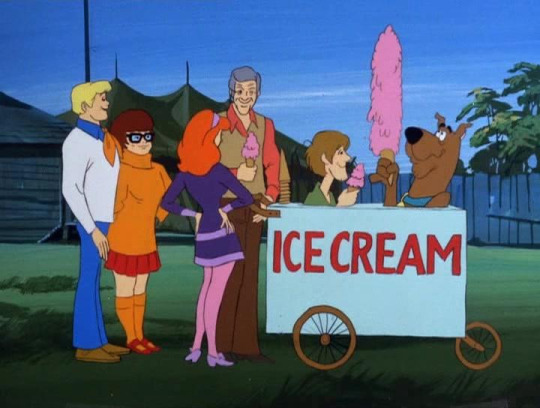
The final episode of this iteration! It follows the gang aiding Dick van Dyke after he opens an amusement park but receives no customers.
Dick is best known for his roles in Mary Poppins and Chitty Chitty Bang Bang, but he’s been in a slew of movies! Despite his position of owning the carnival in this episode, he still is the celebrity, unlike a character like Don Knotts (I think? Still sometimes unsure of what they were going for there). He’s fine in this episode!
I wish I had any thoughts on this episode. It is maybe the most whatever I’ve felt about an episode - nothing stands out, not the villain, a ghostly strongman who is overshadowed by episode fours sportsman, not the guest and not the setting, which is overshadowed by Where are You’s Foul Play in Funland (S1E8).
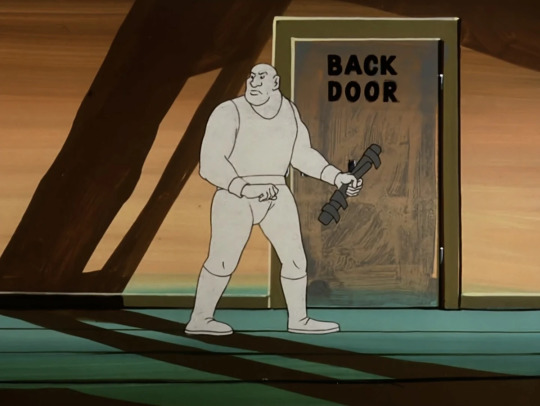
The only note of worth I made about this episode was that I liked the caterpillar ride. Therefore, I won’t drag this out!
That concludes The New Scooby Doo Movies! I’ll post my overall villain and episode ranking in the following weeks where I’ll include a final overview of the series as a whole. Thank you for reading :)
Episode Ranking:
Weird Winds of Winona
The Exterminator
The Haunted Candy Factory
The Haunted Carnival
Villain Ranking:
Cat Creature
Bird Creature
Sea Monster
Mr Hyde
Ghostly Strongman
Hooded Men
Green Globs
Frankenstein's Monster
Creepy Man
Wolfman
Next Review: The New Scooby Doo Movies Villain Ranking
Previous Review: The New Scooby Doo Movies S2 E1-4
#scooby doo#scooby gang#shaggy and scooby#scooby movies#shaggy#velma#daphne#mystery incorporated#velma scooby doo#scooby doo where are you#scooby doo reviews#mystery inc#scooby snacks#horror#reviews#shaggy rogers#fred jones#scooby show#Daphne#Velma#Shaggy#fred#horror show#cartoon#witches#zombies#ghosts
9 notes
·
View notes
Text
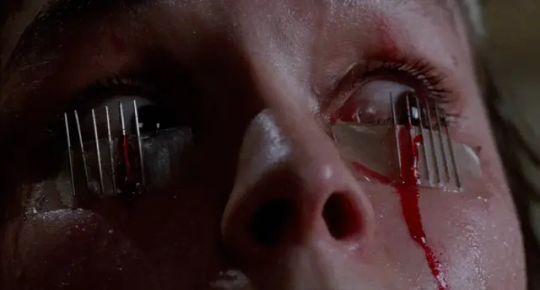
So I'm in the middle of this research project centered on Dario Argento's OPERA, for which I have required myself to watch as many screen adaptations of the Gaston Leroux novel The Phantom of the Opera as I can take. What I have determined so far is that the Phantom of the Opera is a story everyone wants to tell, but not very many people are sure of how to tell it. In fact, it's not that easy to say what it is about archetypally. You know, Wolfman stories are typically about "the beast in man" (with femininity positioned as some sort of cure for this personality split), Frankenstein stories are usually about human nature (i.e. an uncanny creature can have more humanity than vain and bigoted humans), Dracula-type vampire stories are most generally about the problems of being an outsider (queer, foreign, etc). But Phantom of the Opera is like...well, everyone likes the love story part of it, which is more or less modeled on Dracula, with a woman torn between seductive darkness and the safety of square society. But then there are all these other parts that seem to flummox people in the retelling.
I haven't read the Leroux novel YET but the first round of movies have been interesting, and also sort of perplexing. The iteration from 1925 holds up, largely due to Chaney's creation of the Phantom which remains a top tier monster. People don't often talk about the mask though! Which looks like a cross between Peter Lorre and the Devo Boogie Boy, it's disturbing and I like it.


This Phantom was born in the dungeons during a revolutionary bloodbath and is disfigured from birth, drawing on the antique idea that a mother's trauma is translated in the deformity of her children; also, compellingly, these dungeons lie fathoms beneath the opera house where the bourgeoisie are witlessly dancing on the graves of martyrs and criminals embodied in the Phantom. The ingenue Christine is an interesting figure who breaks up with her boyfriend at the beginning because she wants to give her whole self to her career; when the Phantom starts murmuring to her through the walls it's as if the spirit of opera itself has chosen her to be its avatar, which she seems to find totally rational. It's sort of cool, what other movie of this era has a likeable heroine choosing her potential for greatness over love? This is the element of the story that is the most interesting, but I'll expand on that in a minute.

The Chaney edition benefits a lot from keeping things simple. The 1943 version with Claude Raines has a little bit too much going on and the story doesn't get a lot of time to congeal between so many long opera sequences; this movie really takes the opera part of the title seriously! Actually they're the best thing about it, mostly because of Nelson Eddy who is extremely beautiful and a real opera singer, and who projects this blazing desire for Susanna Foster that is incredibly convincing. Like I'd normally say they have great chemistry, but I think it's just a lot of power radiating from him specifically.

Ahem.
Uh anyway. This movie picks up the reoccurring (but not universal) idea that the Phantom is a genteel and sophisticated composer who has just fallen on hard times, who goes mad when his latest concerto is stolen. He is disfigured while struggling with the plagiarist and installs himself under the opera house where he can haunt his former protege Christine, who is already torn between dreamy Nelson Eddy and her stuffy cop boyfriend. One of my favorite things here is that even though this film is extremely quaint and old fashioned, everybody hates cops; this Christine is less a self-determined careerist than someone who is under pressure from her artist friends who find it profoundly repulsive that she is dating a policeman. Meanwhile the Phantom is just way too gentle and sappy, which is extra disappointing because Claude Rains's Invisible Man is so fabulously chaotic and sadistic, it made me really aware of the Phantom that could have been. This one doesn't properly represent the high society vs. underworld dichotomy that Christine should be torn between. So what is this movie about? There's so many guys in it and a few different themes flapping in the breeze. Is it about love? Is it about self-actualizing through art? Is it about the cutthroat world of showbusiness? It doesn't have that much to say, ultimately, and it just seems really unmotivated. Also I don't like this mask, sue me.

The Hammer edition is even more disappointing, considering the studio's previous successes with Universal Monster remakes. Here Christine is torn between a suave opera producer, the lecherous composer who has plagiarized the Phantom, and yeah the Phantom. Too many guys, it confuses whatever the dynamic and themes are supposed to be. Michael Gough as the plagiarist is so much more evil and threatening than poor Herbert Lom's Phantom that it's hard to stay focused on the main point here. Curiously the Hammer version is rather unromantic, with the Phantom just slapping Christine around until she sings his tunes right; that is kind of refreshing in a way, although it also means that the film lacks tension, which contributes to its being surprisingly anticlimactic. The best guy in the movie is actually Thorley Walters whose character serves almost no narrative purpose at all, he just hulks around with this WTF? look on his face and it is kind of adorable. I guess I like the gross mask in this one, too.

But the Hammer version has one interesting strength, which is that Christine is singing the lead in a new opera about Joan of Arc. Just like Joan, Christine hears a disembodied voice prophesizing her ascent to power. The best thing about the Phantom lore is the idea that the woman has this latent power that can either be activated by the Phantom, or suppressed by her square boyfriend (the relationship being mutually exclusive with opera stardom in many iterations). She isn't just a love object to be possessed, she herself possesses of some kind of devastating energy that needs to be awakened and channeled--or contained and forgotten, if she decides to get married and stay home or something. This is pretty cool, and it is interestingly realized in Dario Argento's OPERA, in which (spoiler alert I guess) a killer stalks an opera singer with the aim of catalyzing her own latent psychopathy. This idea is at the center of my thesis and I'm looking forward to fleshing it out, although I'm kind of dreading all the other PHANTOMs that I have committed myself to watching. I really don't want to deal with Andrew LLoyd Webber at all, but after I get through at least the Joel Schumacher one of the those I'm going to reward myself with a rewatch of PHANTOM OF THE PARADISE which I'm going to guess right now is the best retelling of this story after the Chaney one. I'm counting on Paul Williams' music to be catchier than Webber's.

I'm whining about my own decisions, I know, but really the main hardship of this project is that now I keep getting the Vandals' punk theme song from PHANTOM OF THE MALL: ERIC'S REVENGE stuck in my head, and let me tell you that is very unwelcome. Here it is, if you've decided you're done being happy and sane:
youtube
#is this when i finally watch KISS MEETS THE PHANTOM OF THE PARK?#is this project going to destroy me#phantom of the opera#claude rains#lon chaney#herbert lom#dario argento#opera#Youtube
50 notes
·
View notes
Text
So I feel like it's time to spread a little Jewish love, old school style!
Here's a little bit of history that I just found out about while researching something else!
Spotlight: Jewish Fighters!

From left: Bummy Davis and the wrestlers Max Krauser and Martin Levy.
Ever hear of a “Knak” (A hard punch), a “Shtaysl” (uppercut), and “Der gubernator” (Jabbing one’s thumb into a foe’s rib cage)? These are all Yiddish terms used for moves in boxing and wrestling.
Jews, who had been denied most labor jobs and limited to desk work or small jobs, were often seen as scrawny, small, and weak. The intense studious life of studying Torah and furthering their education also left them stereotyped as intellectual book nerds in glasses that would be knocked over in a gentle breeze.
What people don't think of is street smart men with fists of steel.
“[...] but there was always an element of the working class that was tough and street smart and worked with their hands and fought with their hands.” -(Eddy Portnoy, creating of the exhibit at Yivo Institute)
Let’s head back to the 1930s and 1940s when Jewish immigration from Russia and Europe was reaching a peak. Families fled the growing violence and antisemitism and their children faced a new world and the need to assimilate into this new culture.
Boxing became an escape that grew among the Jewish community and quickly gained popularity.
"Zionist and political organizations sponsored boxing and wrestling clubs, and after World War II there were boxing clubs in the refugee camps set up by the Allies."
Several became big names that became well known in most homes.
Jews became the dominating nationality in professional prizefighting during the 30s and 40s. There were 26 Jewish world champions!
Many wore the Star of David on their robes and trunks as a way to represent their Jewish heritage and defy Antisemitism.

Al "Bummy" Davis, born Albert Abraham Davidoff was born in Brooklyn. As a kid, he kept lookout for his father, who sold whiskey during prohibition.
He turned into one of the toughest kids in his area. While his brothers fell into work with the local gang, not even the gang would mess with him.
The name 'Bummy' was actually from his Hebrew nickname "Vroomeleh" given to him by his mother (diminutive of Avrum) that was picked up as Vroomy by his family and friends. Davis apparently was not really a fan of it.
He was known as one of the most powerful left hooks in boxing history and won many of his matches with a total knockout hit.

Max Krauser was born in Poland.
His family owned a tannery where he helped haul the animal skins around.
He went to college and majored in science until he attended a wrestling match at his college.
Randomly jumping into the ring, he defeated the German heavyweight and decided to become a professional wrestler.
His mentor was Zishe Breibart (I'll do a piece on him later), a famous strongman that was also Jewish and a hero to millions.
He quickly became a renowned wrestler throughout Europe where he was the Heavyweight wrestling champion from 1935-1938 until the political atmosphere became too much. He moved to Australia then eventually the USA in 1939,
In America, he was known as "Iron-Head Krauser".

Benny Leonard, born and raised in a Jewish Ghetto in Lower East Side Manhattan and son of Russian immigrants, held the world lightweight championship for eight years from 1917-1925! He later turned his boxing career into a film career. ("The Evil Eye" 1920, and "Flying Fists" 1924-25).

Barney Ross (Dov-Ber Rasofsky) was the Son of a Talmudic scholar who barely escaped a pogrom in Belarus. Once in New York, his father was a Rabbi and owner of a vegetable shop in Chicago. Barney became a Talmudic scholar with the goal to teach. When his father was murdered in a robbery, his mother suffered a breakdown, and his younger siblings were placed in orphanages, Barney fell out of religious practice but never lost his Jewish pride.
Barney started running with tough crowds in the ghetto and got into street brawling and running with Al Capone himself!
With the rise of Nazism and Hitler, Barney took a stance against antisemitism and embraced the fact that he was becoming a well known representative of the Jewish community. His song that played when he entered the ring was "My Yiddishe Momma".
He became a world champion in three weight divisions. He was never knocked out and held his title against big time champions. His last match is quite the famous one where he refused to stop the fight despite the fact that he was taking a severe pounding. He refused to go down and was determined to leave the ring on his own feet. He retired with 72 wins, 22 of them were won by knockout!
He joined the Marines in 1942 and despite being told to stay on US soil as a celebrity, he insisted on going into combat where he was awarded the Silver Star.
(Check out his biography- Barney Ross: The Life of a Jewish Fighter, by Douglas Century and his autobiography No Man Stands Alone.)

Martin "The Blimp" Levy was a wrestler that weighed an astonishing 600 Lbs!
He started his early career in a sideshow as the "Fat Man" at Coney Island!
Despite his massive size, he was astonishingly agile. He is known as one of the first "Giants" of wrestling and helped pave the way for others of his size and character.

Rafael Halperin, the son of a Viennese Ultra-Orthodox Rabbi came into the picture when his family fled to Mandatory Palestine to escape antisemitism and violence.
Rafael took up weightlifting and karate along with his intensive Talmudic studies. He moved to the US and became a renowned wrestler that was known for his Talmudic riddles and for his refusal to fight on the Sabbath.
Halperin also helped organize Israel's first Mr. Israel bodybuilders competition.
He wore a blue and white wrestling outfit with the Star of David across it. In America, he fought under the name "Mr. Israel" and "The Rasslin' Rabbi".
In Israel, he is credited with popularizing professional wrestling.
After he retired from wrestling, he became a Rabbi.
-
Information taken from:
The "Jewish Boxers and Wrestlers, and Yiddish Fighting Words, at Yivo Institute Exhibition" and the "The Yiddish Fight Club" exhibition.
www.nytimes.com/2015/05/01/nyregion/jewish-boxers-and-wrestlers-and-yiddish-fighting-words-at-yivo-institute-exhibition.html?_r=l&referrer
Wikipedia, and "Is Superman Circumcised? The Complete Jewish History of the World's Greatest Hero" by Roy Schwartz
#jumblr#Jewish Fighters#Jewish Boxers#Jewish Wrestlers#1930s-1940s Jews in America#American Jewish History
7 notes
·
View notes